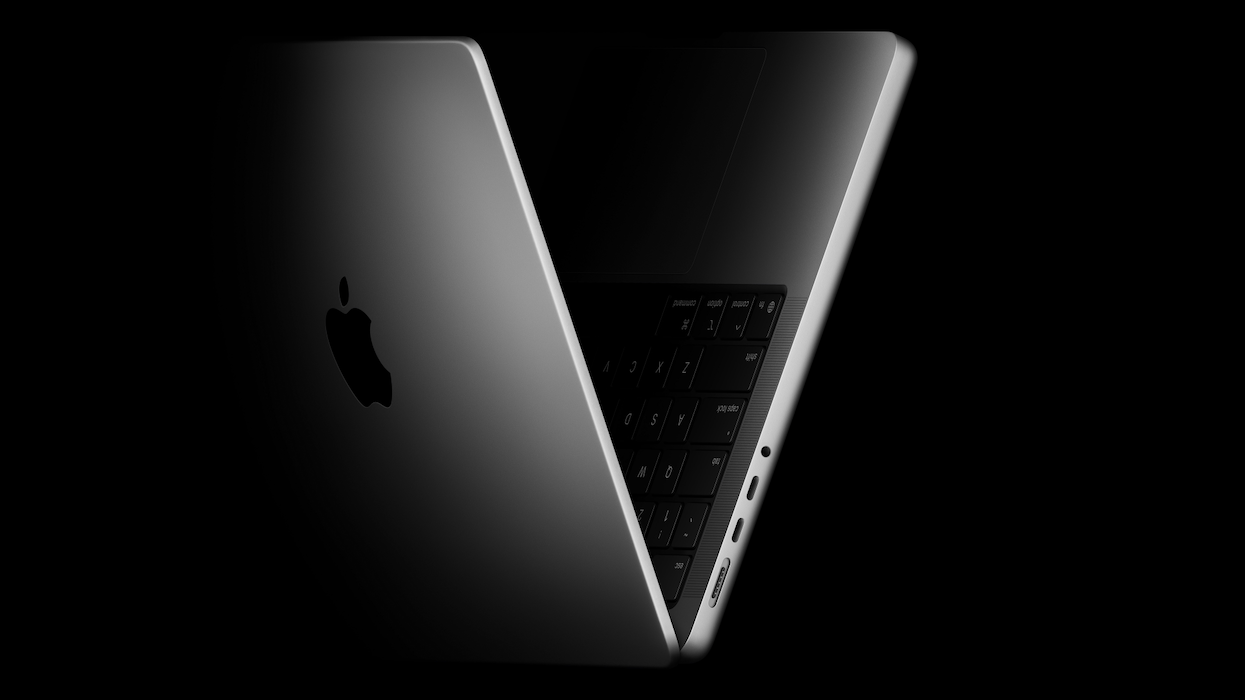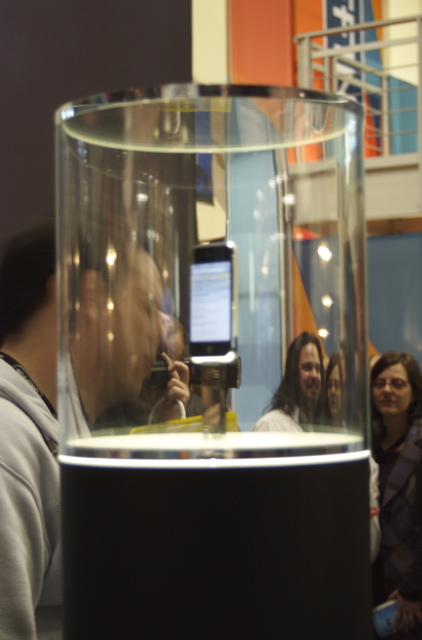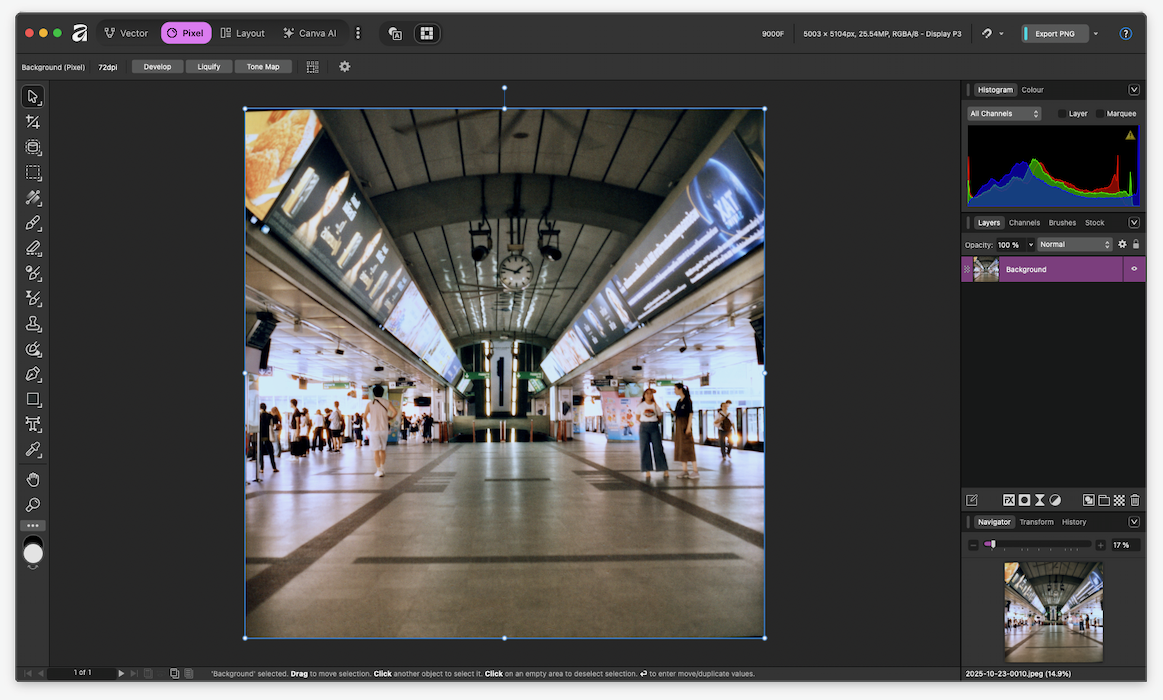
eXtensions - Monday 3 November 2025
By Graham K. Rogers

Apple reported another excellent quarter. With more to come Wall Street analysts are unusually positive. Patents can make or break a company. Sometimes the workarounds are not enough. Ignoring new technology or a new approach can also kill companies. Affinity, now part of Canva, has released a new suite of image editing tools for free. Some have wondered what the catch is. Others are enthusiastic. It does look good.
It is highly likely that Apple will be releasing 26.1 updates to its operating systems within the next few days. As ever, back up your data.
Apple has released its Q4 2025 earnings report and this beats the street. It is significant that both Services ($28.8B), and Mac sales ($8.7B) increased, with Kevan Parekh reporting growth in new users. The iPad revenue was $7B for the quarter. There will probably be more to come next quarter. Revenue for the year was $416 billion.

The main points of the report are:
The Company posted quarterly revenue of $102.5 billion, up 8 percent year over year. Diluted earnings per share was $1.85, up 13 percent year over year on an adjusted basis.1"Today, Apple is very proud to report a September quarter revenue record of $102.5 billion, including a September quarter revenue record for iPhone and an all-time revenue record for Services," said Tim Cook, Apple's CEO. "In September, we were thrilled to launch our best iPhone lineup ever, including iPhone 17, iPhone 17 Pro and Pro Max, and iPhone Air. In addition, we launched the fantastic AirPods Pro 3 and the all-new Apple Watch lineup. When combined with the recently announced MacBook Pro and iPad Pro with the powerhouse M5 chip, we are excited to be sharing our most extraordinary lineup of products as we head into the holiday season."
"Our September quarter results capped off a record fiscal year, with revenue reaching $416 billion, as well as double-digit EPS growth," said Kevan Parekh, Apple's CFO. "And thanks to our very high levels of customer satisfaction and loyalty, our installed base of active devices also reached a new all-time high across all product categories and geographic segments."
Apple's board of directors has declared a cash dividend of $0.26 per share of the Company's common stock. The dividend is payable on November 13, 2025, to shareholders of record as of the close of business on November 10, 2025.
Some of the articles I looked at early in the day are listed here:
With respect to the new M5 MacBook Pro, on a number of occasions I have mentioned my own M1 MacBook Pro, which I have had since Apple Silicon was announced. That is apparently 4 years. I was reminded of this by an article that I linked to from 512 pixels. The writer, Nick Heer was saying how good the M1 MacBook Pro had been, which is the same as my experience: "This MacBook Pro is so good I simply cannot think of a reason I would want to replace it." I can see no reason currently to go for a new Mac.

However, in that same article article he made reference to some of Apple's release notes for macOS 26. Apparently the M1 MacBook Pro may no longer be supported when the next version of macOS is released next year. That means I have better start saving for the M6 Mac.
 When the iPhone was first announced it stunned many companies. Ballmer at Microsoft dismissed it, but was proved wrong (and now admits it) while Redmond no longer makes a smartphone. Blackberry also dismissed the iPhone and, despite the strength of their technology at the time are also no more. Others saw the writing on the wall and rethought their products. Perhaps most significant was Samsung who Apple later accused of copying, and sued. The litigation was not as successful as Apple had hoped. I still think Samsung copied the iPhone.
When the iPhone was first announced it stunned many companies. Ballmer at Microsoft dismissed it, but was proved wrong (and now admits it) while Redmond no longer makes a smartphone. Blackberry also dismissed the iPhone and, despite the strength of their technology at the time are also no more. Others saw the writing on the wall and rethought their products. Perhaps most significant was Samsung who Apple later accused of copying, and sued. The litigation was not as successful as Apple had hoped. I still think Samsung copied the iPhone.
Other Apple products have been copied, such as the iMac, with a number of similar products appearing. Some notebook computers have also seen a change from black plastic to an aluminium finish, just like the MacBook Pro. Jowi Morales (Tom's Hardware) reports on a couple of products from the Chinese company, Orico that bear a remarkable resemblance to the Mac Pro and Mac mini. A quick glance at either of these and some might be fooled. A closer look shows a number of differences, but the overall design is (shall we call it) Mac-like.
Companies (and people) are often inspired by the products of another, and Alex Cooke (PetaPixel) writes on a massive patent battle that took place, starting in the 1970s, that indirectly led to the end of the two companies involved: Polaroid and Kodak. Currently, Fuji has an instant camera range that is popular with young people, but the company that owned the technology was Polaroid. The founder, had tied everything up with patents to such an extent that no other company was able to break the market. Kodak looked at that market, and the patents. They thought that they could work round the patents with their skills. In the end they were wrong and the damages awarded cost them dearly.
While the extended court battle was taking place, both companies took their eye off the ball. They had invested heavily - almost totally - in film technology and did not react in time to the growth of digital photography. The irony here is that Kodak invented it. They were so sure of their analog history, that they failed to react to the digital deluge. What is doubly ironic (Cooke does not mention this) is that Kodak developed an early digital camera with Apple: the QuickTake. The QuickTake 100 had a Kodak sensor. The QuickTake 200 had the same sensor and was built by FujiFilm. There were plans for more sophisticated versions, but when Steve Jobs returned to Apple, the product was killed. By this time other manufacturers were making digital cameras. Now it is hard to find film cameras, but some of us still enjoy the older technology.

|

|
We had been anticipating a new release from the former developers of Affinity software for a week or so, and this was made available for the Mac and for Windows this week. An iPad release is to follow soon. The whole suite (Design, Photo, Publisher, Vector) is available for free. Affinity is now part of Canva, and to download the new software needs a Canva account. I don't want to be cynical here, but how free is free?
There is a video from Ash who introduces the new software and runs a mini-tutorial. Comments with the video express similar misgivings: nothing in this world is free; will Canva AI be trained using our data; there has to be a catch. Some commented that (like me) they prefer software that can be bought and owned (a lesson for Adobe there). While the new features are impressive, several commentators were less in favour of the AI aspects. I am also with them there. A link to the site provides a lot more details about the new version. A download button is available.
To download the software, I had to create a Canva account, which was fairly easy. Both Mac and Windows downloads were available to me. The download took 5 attempts before the 981.4MB file could be opened: lost connection, I was told. Perhaps they were having a busy day. The download was much better on Monday morning at my office where links are often slow. This is not available from the Mac App Store. As is normal, I dropped it into the Applications folder. When first started, the app goes through a couple of checks and opens introductory panels: the second one asks for permission to share my usage data. I turned this off. Using the app itself is relatively easy, although it has a lot more tools than I am likely to want. There were no Terms & Conditions to sign up to, so I am still wondering, with all the features available to me for zero cost, what is the catch?

Jaron Schneider (PetaPixel) was delighted by the decision that the software would be provided free and compared it to Da Vinci Resolve. As with that software, most of us can get away with the features that come with the basic version, but should any user want to unlock the AI features, then that is possible with the paid option from Canva at $15 a month. He notes that with this approach, Canva/Affinity could pose a real threat to the status quo: Adobe. Also from Jaron Schneider is an article in which he looks at Canva's approach to what it calls its Creative Operating System; while Jeremy Gray - also PetaPixel - takes another look at the new Affinity app. These three articles are from the points of view of writers who work in photography so are worth a look from that specific angle.
With Canva releasing these new versions of Affinity software, we should remember that Apple now owns a company that had similar software: Pixelmator. William Gallagher (AppleInsider) suggests that Pixelmator Pro could be available on the iPad soon along with Motion 5, Compressor and Main Stage. The last three are linked to Apple's Final Cut and Logic of course, while Pixelmator Pro is a standalone image editor.
Graham K. Rogers teaches at the Faculty of Engineering, Mahidol University in Thailand. He wrote in the Bangkok Post, Database supplement on IT subjects. For the last seven years of Database he wrote a column on Apple and Macs. After 3 years writing a column in the Life supplement, he is now no longer associated with the Bangkok Post. He can be followed on X (@extensions_th). The RSS feed for the articles is http://www.extensions.in.th/ext_link.xml - copy and paste into your feed reader. No AI was used in writing this item.

For further information, e-mail to
Back to
eXtensions
Back to
Home Page